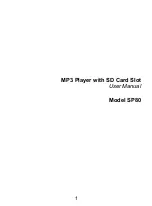
Appendices : MPEG Settings (MainConcept Encoder)
Page 259
The Mux Rate is the total bitrate, i.e. video bitrate plus audio bitrate plus muxing overhead bitrate. This option
specifies the bitrate of the multiplexed program stream.
Startup delays (ms):
The
Pack
value specifies the starting TimeCode of the muxed stream (this can be different than the starting Time-
Code of the video stream). It is the starting SCR (= System Clock Reference) in ms of the program stream. The Video
and Audio delays are respective to the Pack delay
For example, if you set the Pack delay to 500 ms, and the Video as well as the Audio delays to 300 ms, the first SCR
of the stream would be 500 ms, and the first video and audio PTS (= Presentation Timestamps) would be 800 ms.
If you make the Pack delay five seconds (5000 ms) and the Audio/Video delays 400 ms the first SCR would be 5000
ms and the first audio/video PTS would be 5400 ms.
The
Video
,
Audio1
and
Audio2
delays actually specify the starting time of the respective stream (relative to the
pack delay).
If these settings do not match, the streams will start at different times. Normally they are the same, but say you
have a video stream and an audio stream where you know the audio actually starts 500 ms after the video, you
would set the video delay to some value and set the Audio1 delay to Video delay + 500, this would then synchro-
nize the two streams when played.
For example, if you specify the Pack delay as 0 ms (the normal case), the Video delay as 200 ms and the Audio delay
as 300 ms, the first SCR will be 0, the first video PTS would be 200 ms and the first audio PTS would be 300 ms. This
would shift the audio/video synchronization, so the audio is 100 ms behind the video.
Video Options:
Buffer Size (kB):
These settings specify the size of the buffers needed to decode the video. If it is too low, you will get buffer over-
flows, which could show up as stuttering video. Usually it is set to the same size as the video VBV buffer (although
the VBV units are half these units), DVD specifies 232 for the video buffer. Software decoders usually ignore the
buffer sizes, but most hardware players will have problems if the buffer size is not correct.
VBV is the abbreviation of Video Buffering Verifier. It is a hypothetical decoder with a buffer whose size is specified
by the Video Buffer Size. Encoded pictures from the MPEG stream are placed into the buffer (hypothetically) and
removed from the buffer at regular intervals. The MPEG video stream is supposed to be constructed by varying the
size of the encoded frames such that the buffer does not underflow (i.e. becomes empty where there are no
frames in the buffer when it is time to decode one) or overflow (i.e. becomes full where no space is available for
more encoded pictures).
Pulldown:
This option contains four parameters: None, 2:3, 3:2 and Auto. When pulldown is present in the video stream, the
multiplexer must adjust the PTS/DTS timestamps to account for the extra fields displayed. This option should be
set to the same value as the video pulldown setting (or to Auto).
Timestamps:
You find All frames, I & P frames and I frames in this menu. Here you can choose which frames in the stream have a
timestamp attached. The timestamps are needed for synchronization of video and audio. In general, it is enough
to set this option to I Frame. For particular formats the values are clearly defined.
Split File Options:
Max. file size
: You enter the value (in MBs) here, from which a further file shall be written.
Reset clocks:
If Reset clocks is enabled, the SCR, PTS and DTS clocks are reset to the 'startup delay' values (the
starting values) when starting a new file. This would make the TimeCodes in each of the files start with the same
values. If disabled, the clocks are not reset and the TimeCodes would be continuous from one file to the next.
Set broken link flag in GOP:
This option has to do with the way MPEG compresses frames. Usually a GOP consists
of 1 I frame and several B and P frames. I frames are not dependent on any other frames, P frames are normally
dependent on the preceding P or
I frame, and B frames are normally dependent on the preceding and successive I or P frames.
Summary of Contents for VCube
Page 1: ...USER MANUAL User Manual...
Page 9: ...Page 9 Document revision 22 Date 28th November 2012...
Page 13: ...Introduction VCube Keys Options Page 13 VCube Versions...
Page 231: ...Appendices HDTV Recorded Media Page 231 HDTV Recorded Media SDTV Recorded Media...
Page 264: ...Appendices Pro Tools VCube Operation Page 264 Pro Tools VCube Operation...
Page 270: ...Appendices Pro Tools and VCube Page 270...
Page 273: ...Appendices Pro Tools and VCube Page 273...
Page 274: ...Appendices Pro Tools and VCube Page 274...
Page 275: ...Appendices Sony 9 Pin RS422 Wiring Chart Page 275 Sony 9 Pin RS422 Wiring Chart...
Page 276: ...Appendices Sony 9 Pin RS422 Wiring Chart Page 276...
Page 277: ...Appendices Sony 9 Pin RS422 Wiring Chart Page 277...
Page 278: ...Appendices Sony 9 Pin RS422 Wiring Chart Page 278...
















































